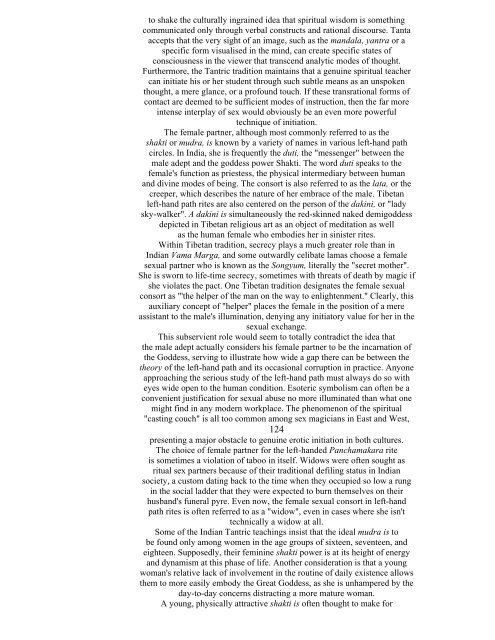I. VAMA MARGA Foundations Of The Left-Hand Path - staticfly.net
I. VAMA MARGA Foundations Of The Left-Hand Path - staticfly.net
I. VAMA MARGA Foundations Of The Left-Hand Path - staticfly.net
You also want an ePaper? Increase the reach of your titles
YUMPU automatically turns print PDFs into web optimized ePapers that Google loves.
to shake the culturally ingrained idea that spiritual wisdom is something<br />
communicated only through verbal constructs and rational discourse. Tanta<br />
accepts that the very sight of an image, such as the mandala, yantra or a<br />
specific form visualised in the mind, can create specific states of<br />
consciousness in the viewer that transcend analytic modes of thought.<br />
Furthermore, the Tantric tradition maintains that a genuine spiritual teacher<br />
can initiate his or her student through such subtle means as an unspoken<br />
thought, a mere glance, or a profound touch. If these transrational forms of<br />
contact are deemed to be sufficient modes of instruction, then the far more<br />
intense interplay of sex would obviously be an even more powerful<br />
technique of initiation.<br />
<strong>The</strong> female partner, although most commonly referred to as the<br />
shakti or mudra, is known by a variety of names in various left-hand path<br />
circles. In India, she is frequently the duti, the "messenger" between the<br />
male adept and the goddess power Shakti. <strong>The</strong> word duti speaks to the<br />
female's function as priestess, the physical intermediary between human<br />
and divine modes of being. <strong>The</strong> consort is also referred to as the lata, or the<br />
creeper, which describes the nature of her embrace of the male. Tibetan<br />
left-hand path rites are also centered on the person of the dakini, or "lady<br />
sky-walker". A dakini is simultaneously the red-skinned naked demigoddess<br />
depicted in Tibetan religious art as an object of meditation as well<br />
as the human female who embodies her in sinister rites.<br />
Within Tibetan tradition, secrecy plays a much greater role than in<br />
Indian Vama Marga, and some outwardly celibate lamas choose a female<br />
sexual partner who is known as the Songyum, literally the "secret mother".<br />
She is sworn to life-time secrecy, sometimes with threats of death by magic if<br />
she violates the pact. One Tibetan tradition designates the female sexual<br />
consort as "'the helper of the man on the way to enlightenment." Clearly, this<br />
auxiliary concept of "helper" places the female in the position of a mere<br />
assistant to the male's illumination, denying any initiatory value for her in the<br />
sexual exchange.<br />
This subservient role would seem to totally contradict the idea that<br />
the male adept actually considers his female partner to be the incarnation of<br />
the Goddess, serving to illustrate how wide a gap there can be between the<br />
theory of the left-hand path and its occasional corruption in practice. Anyone<br />
approaching the serious study of the left-hand path must always do so with<br />
eyes wide open to the human condition. Esoteric symbolism can often be a<br />
convenient justification for sexual abuse no more illuminated than what one<br />
might find in any modern workplace. <strong>The</strong> phenomenon of the spiritual<br />
"casting couch" is all too common among sex magicians in East and West,<br />
124<br />
presenting a major obstacle to genuine erotic initiation in both cultures.<br />
<strong>The</strong> choice of female partner for the left-handed Panchamakara rite<br />
is sometimes a violation of taboo in itself. Widows were often sought as<br />
ritual sex partners because of their traditional defiling status in Indian<br />
society, a custom dating back to the time when they occupied so low a rung<br />
in the social ladder that they were expected to burn themselves on their<br />
husband's funeral pyre. Even now, the female sexual consort in left-hand<br />
path rites is often referred to as a "widow", even in cases where she isn't<br />
technically a widow at all.<br />
Some of the Indian Tantric teachings insist that the ideal mudra is to<br />
be found only among women in the age groups of sixteen, seventeen, and<br />
eighteen. Supposedly, their feminine shakti power is at its height of energy<br />
and dynamism at this phase of life. Another consideration is that a young<br />
woman's relative lack of involvement in the routine of daily existence allows<br />
them to more easily embody the Great Goddess, as she is unhampered by the<br />
day-to-day concerns distracting a more mature woman.<br />
A young, physically attractive shakti is often thought to make for
















